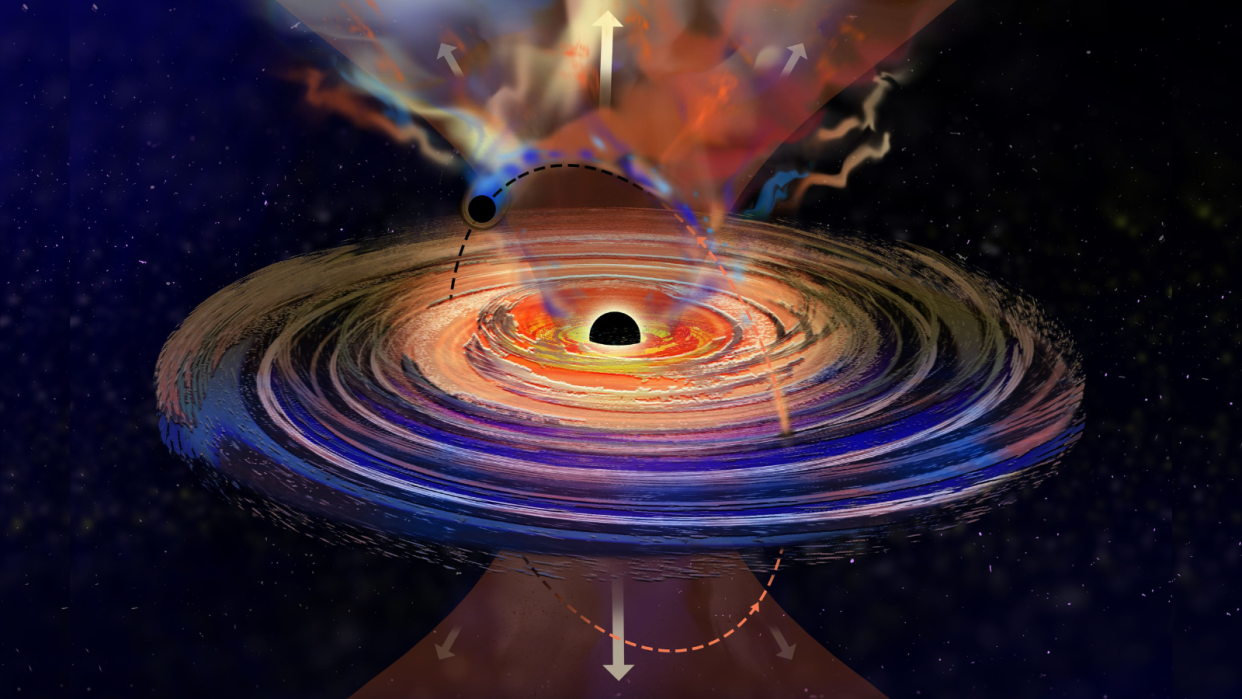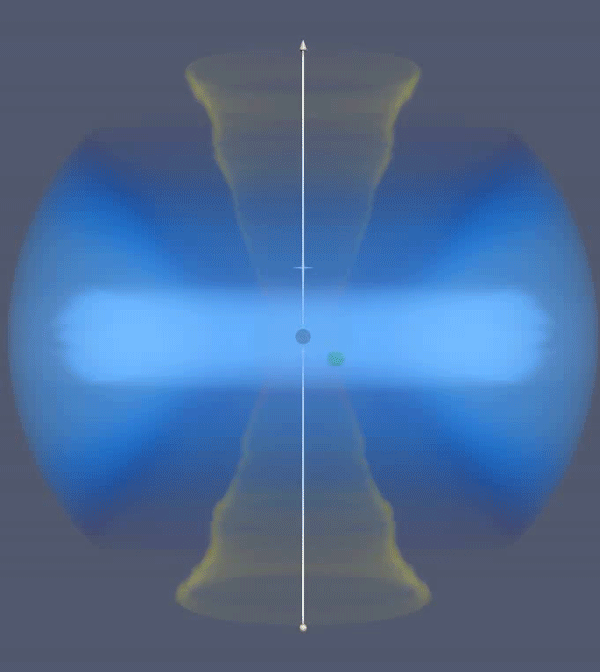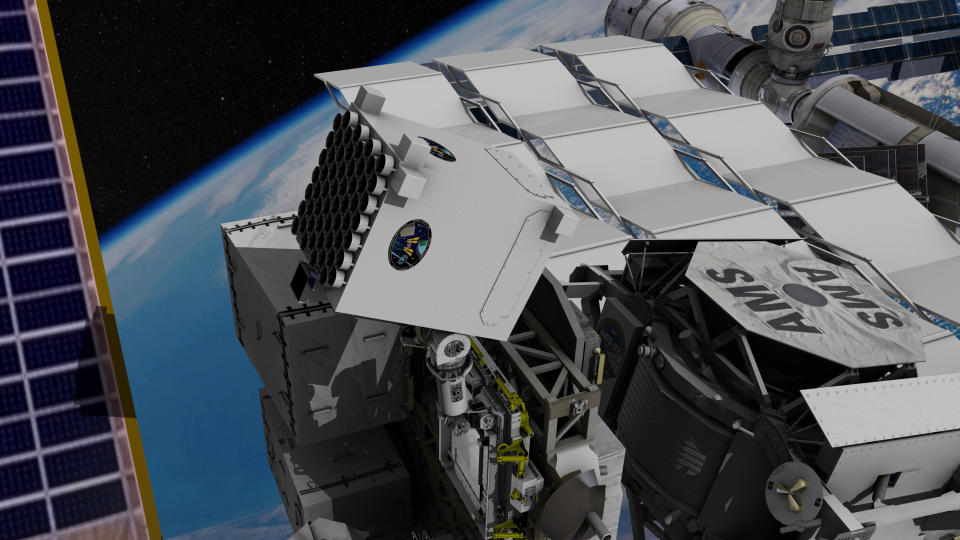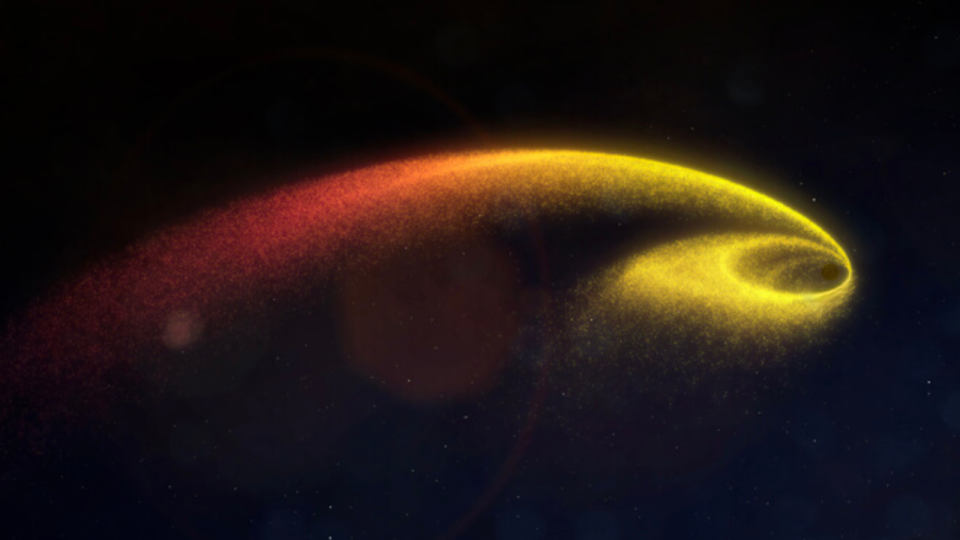Supermassive black hole’s mysterious hiccups' likely caused by neighboring black hole's 'punches'

A hiccuping supermassive black hole has alerted astronomers to a whole new type of black hole behavior.
In 2020, a previously quiet black hole at the heart of a galaxy about 800 million light-years from Earth, and with a mass equivalent to 50 million suns, suddenly erupted, brightening the material around it by a factor of 1,000.
A team of researchers thinks that these periodic eruptions are caused by a second, smaller black hole slamming into a disk of gas and dust, or "accretion disk," surrounding the supermassive black hole, causing it to repeatedly "hiccup" out matter.
The findings challenge the conventional picture of how black hole accretion disks function. Previously, scientists had believed they were uniform disks of gas and dust rotating around a central black hole. The new results, however suggest that some accretion disks could harbor exotic components, such as stars and even smaller secondary black holes.
"This is a different beast. It doesn’t fit anything that we know about these systems. We thought we knew a lot about black holes, but this is telling us there are a lot more things they can do," study team member Dheeraj "DJ" Pasham, a scientist at the Massachusetts Institute of Technology's Kavli Institute for Astrophysics and Space Research, said in a statement.
"We think there will be many more systems like this, and we just need to take more data to find them," Pasham added.

Hunting a 'different beast' black hole system
The team was initially tipped off about this hiccuping black hole while examining data from the All Sky Automated Survey for SuperNovae (ASAS-SN), a network of 20 telescopes around the globe that scan the entire sky over Earth once a day.
As ASAS-SN was automatically scanning the sky in December 2020, the robotic telescopes saw a burst of light in a hitherto quiet patch of sky containing a galaxy located about 800 million light-years away. Pasham chased down this flare-up using the Neutron star Interior Composition Explorer (NICER), a NASA X-ray telescope on the International Space Station (ISS).
Pasham had just a short time left to use the ISS-based telescope, which is employed to hunt the cosmos for X-ray bursts that erupt from neutron stars, black holes, and other extreme gravitational phenomena, meaning he had to act fast and get lucky.
"It was either use it or lose it, and it turned out to be my luckiest break," Pasham said.
The researcher saw that this galaxy was continuing to flare, with its outburst lasting around four months. In NICER observations of this flaring, Pasham spotted a curious pattern of subtle dips in X-rays and the energy of the burst every 8.5 days. The signal almost resembled the dip in light caused when an exoplanet crosses or "transits" the face of its star, briefly blocking its starlight.
"I was scratching my head as to what this means, because this pattern doesn’t fit anything that we know about these systems," Pasham added.
Related: 7 ways to discover alien planets

Pasham's confusion was alleviated when he found research suggesting that a supermassive black hole at the heart of a galaxy could be orbited by an intermediate-mass black hole, a black hole with a mass between 100 and 10,000 times that of the sun.
This smaller black hole could be orbiting its larger counterpart in such a way that it swoops in and out of the supermassive black hole's accretion disk. As it punches through this gas and dust, the smaller black hole slams out a plume of gas. Each dive would create another plume, hence the periodic pattern of these "hiccups."
If those plumes are directed toward Earth, they could be sighted as a sudden drop in energy from the affected system as light from the accretion disk is periodically obscured, just as starlight is by a transiting exoplanet.
"I was super excited by this theory, and I immediately emailed them to say, ‘I think we’re observing exactly what your theory predicted'," added Pasham.
This prompted the authors of that initial research to create simulations incorporating NICER data. These confirmed the observed 8.5-day signal is likely the result of a small black hole punching through the accretion disk of its larger supermassive black hole companion.
What caused the supermassive black hole to hiccup? Too much spaghetti
This still doesn't explain why the supermassive black hole suddenly erupted, however — just why this burst periodically dims. The team thinks that this black hole sprang to life because a star recently wandered too close to its outer boundary or "event horizon."
The massive gravitational influence of the supermassive black hole would generate immense tidal forces in approaching stars, stretching them vertically and squashing them horizontally, in a process called "spaghettification." This would result in the star being shredded in a tidal disruption event, causing a powerful burst of light and a sudden influx of matter that brightened the accretion disk.

In the case of the newly observed galaxy, the added material apparently fed the supermassive black hole for four months, the duration of the burst, and also meant that when the smaller secondary black hole plunged through this material, it sent flying a larger plume of gas than usual.
"We’re seeing evidence of objects going in and through the disk at different angles, which challenges the traditional picture of a simple gaseous disk around black holes," Pasham said. "We think there is a huge population of these systems out there."
RELATED STORIES:
— The giant black hole of galaxy M87 shoots jets at nearly light speed
— 1st black hole ever imaged by humans has twisted magnetic fields and scientists are thrilled
Richard Saxton is an X-ray astronomer from the European Space Astronomy Centre in Madrid who was not involved in the research. He said that the new findings, and the technique used to reach them, could end up helping astronomers better understand supermassive black holes and the exotic environments they inhabit.
"This result shows that very close supermassive black hole binaries could be common in galactic nuclei, which is a very exciting development for future gravitational wave detectors," Saxton said in a statement. "This is a brilliant example of how to use the debris from a disrupted star to illuminate the interior of a galactic nucleus which would otherwise remain dark. It is akin to using fluorescent dye to find a leak in a pipe."
The team's research was published on Wednesday (March 27) in the journal Science Advances.


